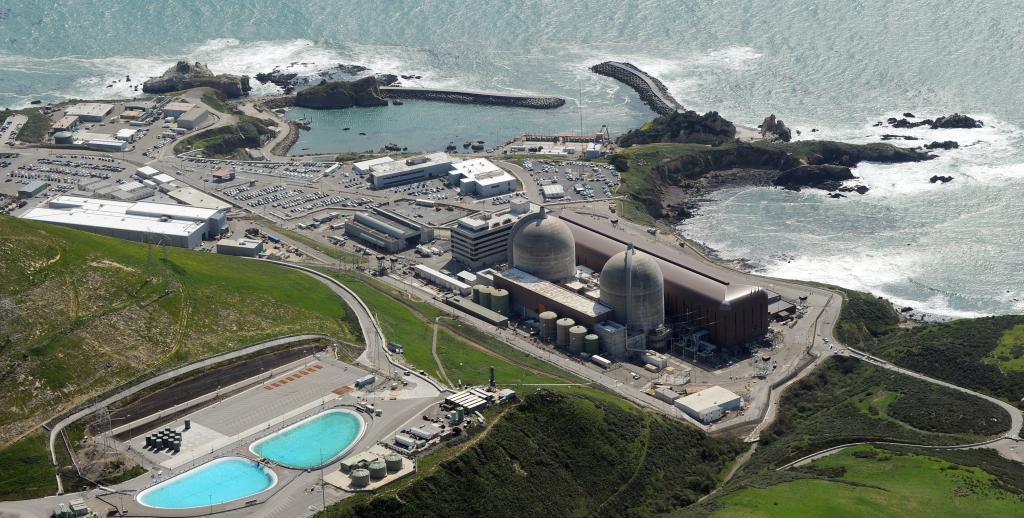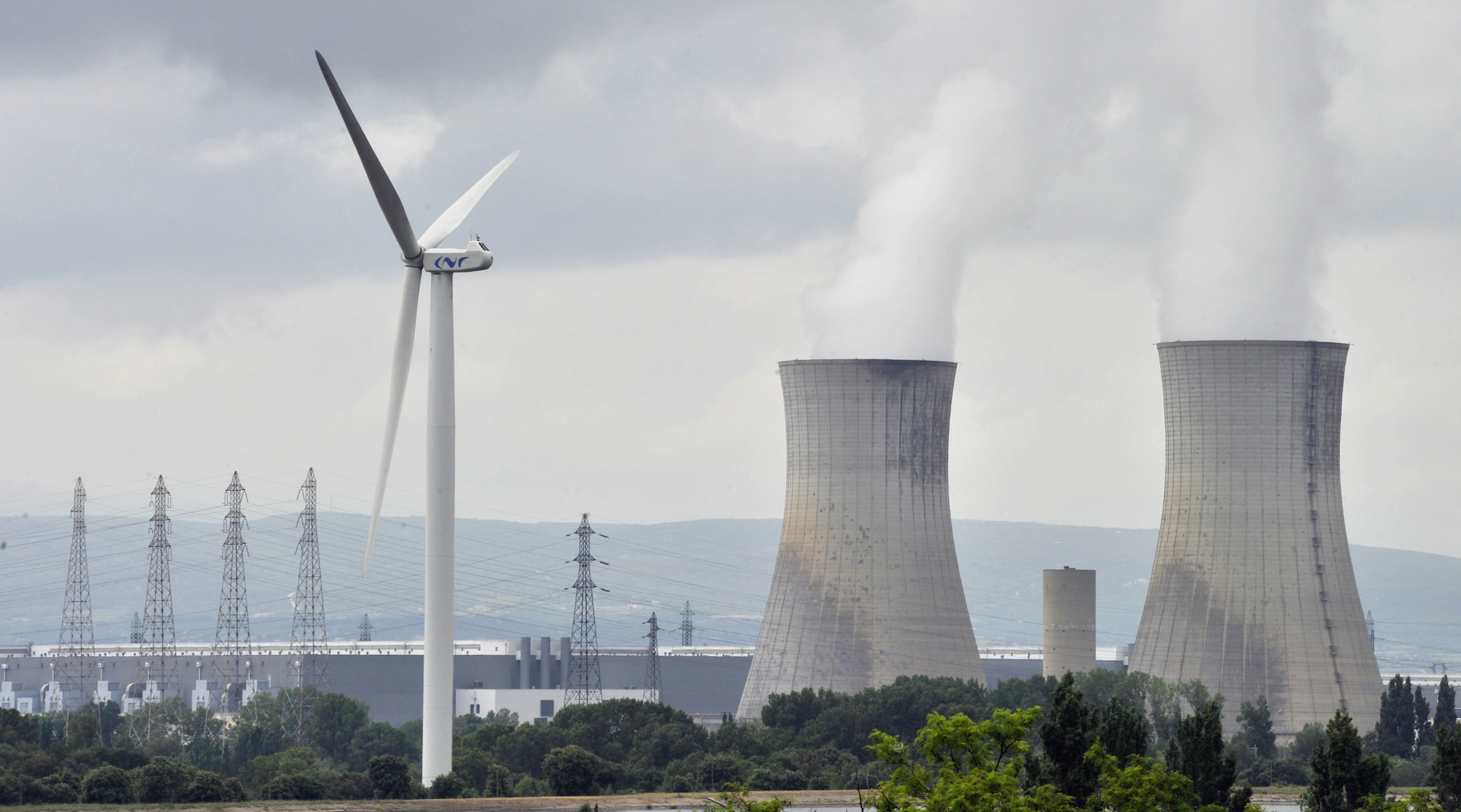The world is charging closer to the climate cliff, and the fact that we’ve failed to bring down greenhouse gas emissions amid the largest renewable energy boom in history has rendered old certainties, well, less certain: The big environmental groups have softened their stances on the issue of nuclear energy. OG climate hawk James Hansen is now saying we need it in the mix to deal with climate change. Meanwhile, the previously pro-nuclear Chancellor of Germany, Angela Merkel — who became convinced her country could rid its electrical grid of carbon without it — began shutting down her nuclear fleet after the Fukushima disaster.
As we begin the shift off of fossil fuels, there’s pitched debate about whether nuclear should be a part of the new energy mix. After sifting through all the evidence, the International Panel on Climate Change wrote that getting greenhouse gases out of our system “will require more intensive use of low-GHG technologies such as renewable energy, nuclear energy, and [carbon capture and storage].” Without nuclear, according to the IPCC projections, we are less likely to keep the planet from disastrous levels of warming, and the effort will be more expensive.
It’s hard not to take the IPCC as definitive, but it’s worth untangling the issues at play to see whether nuclear is truly essential to a future clean energy economy.
Nuclear power’s strength is also its weakness
Nuclear reactors are good at providing a steady stream of electrons — keeping your refrigerator cold 24 hours a day — while the wind gusts and calms and the sun rises and falls. In the United States, the reactors almost always run flat out.
But they don’t have to — it’s technically possible to turn them up and down. Because nuclear plants cost a lot to build and run, it makes sense to squeeze as much power out of them as possible, says Massimiliano Fratoni, a nuclear engineer at the University of California, Berkeley. “Part of this is also cultural,” Fratoni says. “It’s a point of pride to be able to keep the plant operating at 90 percent of capacity.”
So nuclear’s strength is consistency, but its consistency is also a weakness — especially in a paradigm where you need nuclear to simply fill in for interruptions in wind or solar. Ramping down decreases revenue, but expenses stay the same: These big plants cost billions to build and have hundreds of employees, many on salary. Slow down the stream of electrons from a nuclear plant and you still have to issue all those paychecks. But you stop making money.
Warning: Dungeons and Dragons metaphor ahead
Think of the various electricity sources — solar panels, wind turbines, gas motors, etc. — as characters in a role-playing game: warrior, healer, rogue wizard. Each has a special power and a weakness.
The special ability of solar and wind characters is that they can turn a free resource into electricity. The problem, of course, is that this special ability depends on the whims of nature. Another bunch can generate power whenever needed but at a high price; hence, you can’t ask too much of them. Batteries and “peaker plants,” which run only when there’s high demand — usually on natural gas — fall into this class. Last, there’s a workhorse group, made up of nuclear and most fossil fuel plants, that can do a little of everything. They can produce electricity at will but can’t fill a sudden deficit as fast as a battery or a peaker. And, of course, they put out electrons more expensively than renewables running on free fuel.
Jesse Jenkins, a graduate researcher studying pathways to decarbonization at the Massachusetts Institute of Technology, has named these three forms of electricity generation “fuel saving” (intermittent renewables), “fast burst” (batteries and peakers), and “flexible base” (the rest). Understanding this flexible-base category is key to understanding why we might want to use nuclear, and whether we could move forward without it.
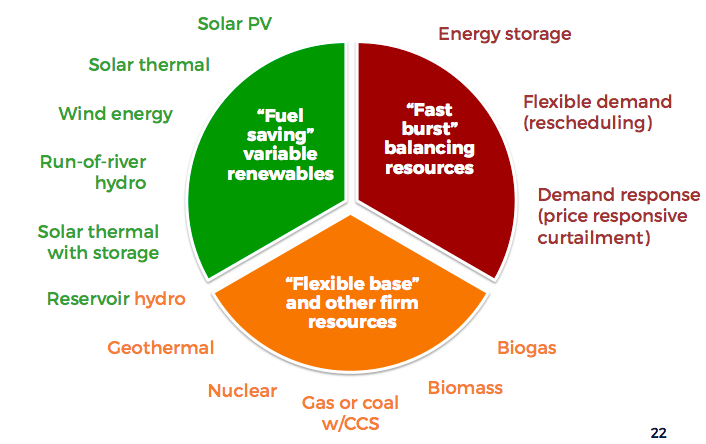
The exercise here is to assemble a team that can work together. There are strategies that favor maximizing one class, and others that favor a mix. You win — well, we all win — by putting together a combination of these generators to get us to a zero-carbon electrical system. The rub is that everything in the flexible-base category has problems.
Different combinations for zero carbon
Jenkins has been researching the question of how we get to a zero-carbon electric system for years now, and it’s convinced him that the cheapest route is to find a mix of all three categories. It’s no surprise that daily electricity use starts to ramp up in the morning, as people wake up and begin toasting bread, and begins to fall when they switch off the lights at night.
According to Jenkins’ work, it’s possible to get to zero carbon with just the fuel-saving and fast-burst sources (essentially, renewables and storage). In that scenario: There’s no need for input from the flexible-base category. But here’s the problem: In order to eliminate the flexible-base sources entirely, you’d have to build enough renewables and storage to satisfy peak demand even when there’s barely any sun or light.
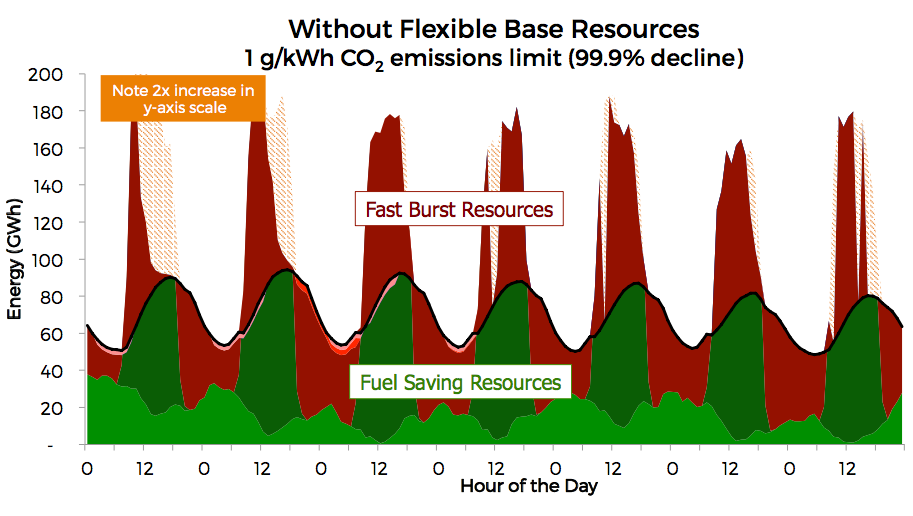
The black line in this graph shows the daily rise and fall of electricity use, with electricity production fluctuating around it. According to Jesse Jenkins’ work, it’s possible to get to zero carbon with just renewables and storage — and no input from fossil-fuel or nuclear plants.
“It’s expensive,” technologist Ramez Naam told Grist last year, by which he meant erecting enough turbines to catch stray gusts of wind or panels to catch a lone ray of sunlight. “You have a lot of capacity you don’t need most of the time.”
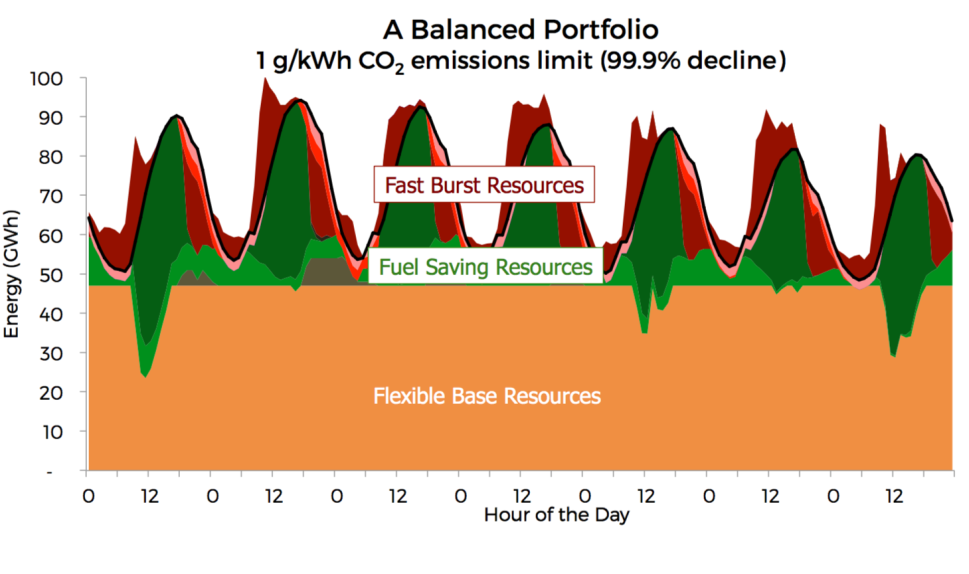
In a power grid that’s 99-percent carbon free, using a mix of all three resources — fast burst, fuel saving, and flexible base — traditional power plants and nuclear facilities crank out a baseline of the overall energy generation. Jesse Jenkins
But nuclear is expensive, too
I was initially bewildered by the assertion that renewables can be expensive, because there are stories every day about how renewables are the cheapest form of power out there. It’s surprising to hear from Naam that turning our entire power supply over to them is so pricey. Nuclear is relatively costly, as well — and ramping nuclear down makes it even more so.
That said, according to Juan Pablo Carvallo, who studies energy systems at the Lawrence Berkeley National Laboratory, it’s not all that helpful to compare the prices of power plants in different categories because they are providing totally different services.
Returning to my very nerdy role-playing analogy: Let’s say healers are cheaper to recruit than warriors or wizards, but if you only pick healers, you’ll be in trouble when the swords come out. You’d want to compare the cost of the various combinations of characters that can get the job done. And you’d want to evaluate the overall cost of the team, not just the cost of the individual members. As a society, we pay for the entire electrical system, Carvallo explains, so we should be comparing different teams of generators that work together to provide low-carbon electricity, not the costs of individual plants.
Nearly every model of a working low-carbon electrical system uses some flexible-base power plants as part of the team. And once renewables are accounting for around 80 percent of the electrical supply, Jenkins discovered, it really starts to make economic sense to add nuclear to the mix.
But, according to Craig Morris, a fellow at the Institute for Advanced Sustainability Studies in Potsdam, Germany, Jenkins is too optimistic about nuclear ramping to fill in for renewable electricity. In a new paper, Morris shows that grid managers will ramp down every other form of generator before ramping down nuclear. After all, they just aren’t designed to be agile. He notes that in France, where 75 percent of electricity comes from nuclear reactors, the nuclear fleet as a whole has never ramped down by more than one third. He’s skeptical that a fleet like France’s can do more than that.
Alternatives to nuclear
Any new reactors built in Europe will be better at ramping, but Jenkins adds we don’t necessarily need nuclear — we just need a coherent plan for getting to zero carbon. If we want a non-nuclear option for flexible-base generation, there are other contenders:
*Geothermal power is viable in just a few places where there’s hot water close to the surface. But we might be able to make more of these by using fracking techniques to break up rocks and create conduits to underlying magma.
*Biomass requires a lot of land — you’ve got to grow the fuel before you burn it — and it produces pollution. But in the western United States, forests are suffering from an excess of fuel from years of overzealous fire prevention. It might be better to put that smoke into the air in a controlled manner, than having a fire release it all at once.
*Capturing the carbon from fossil fuel plants doesn’t eliminate air pollution or giant coal mines. And it is hugely expensive. But as we push forward into a zero-carbon future, the same economics that start to make nuclear viable could work for carbon capture and sequestration, as well.
*Long-term storage, like some kind of battery that could charge up over the summer and then provide a week of power in a cold, windless January. We’re nowhere close to figuring this one out, though hydroelectric dams can act as batteries. When you have excess power you can pump water back up behind a dam, and then run it down through the turbines when you need electricity. But we don’t have much pumped hydro and just building the massive tubes and secondary reservoirs you need to make it work would draw fervent opposition. And that’s before we discuss building new dams.
We should probably be working on all of these options. Going 100 percent renewable really could work, especially for rich places like Germany and California. But it will be cheaper and faster if we have some workhorse generation to fill in the gaps. That’s why the International Panel on Climate Change found that, without nuclear, we are less likely to keep the planet from disastrous levels of warming, and the effort will be more expensive.
The takeaway
We could really use a low-carbon class of energy generation that flexes smoothly with the ebb and flow of renewables. That simply doesn’t exist right now. Existing nuclear power plants don’t flex efficiently … but they can flex, inefficiently, if they have to.
The modern debate turns on prices. If you think of power plants as interchangeable black boxes that spit out electrons, it’s hard to find any reason to build nuclear reactors. But if you’re differentiating between the various categories of power plants — if you want workhorses to supplement the times when renewables and batteries show their weaknesses — nuclear can make a lot of sense.
